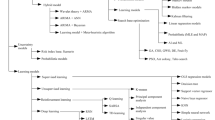Abstract
This paper presents a trajectory generation algorithm for robots which can walk like human with movable foot and active toe. The proposed algorithm allows smooth transition between walking phases namely, single and double support phases. A neural network approach is used for solving inverse kinematics so that the biped robot follows the ankle and hip trajectories to walk. Zero moment point (ZMP) stability is ensured by taking into account the upper body movements along with the planned motion trajectories. Here, we analyze the effect of lateral upper body motion on ZMP stability. Different types of trajectories for upper body are generated, and the one which ensured the most stable locomotion is identified.

























Similar content being viewed by others
Explore related subjects
Discover the latest articles, news and stories from top researchers in related subjects.References
Vukobratovic M, Borovac B (2004) Zero-moment point-Thirty five years of its life. Int J Humanoid Robot 1:157–173
McGeer T (1990) Passive walking with knees. In: Proceedings of the IEEE-ICRA, pp. 1640–1645
Sarkar A, Dutta A (2014) 8-DoF biped robot with compliant-links. Robot Auton Syst 63:57. https://doi.org/10.1016/j.robot.2014.09.014
Sakagami Y, Watanabe R, Aoyama C, Matsunaga S, Higaki N, Fujimura K (2002) The intelligent ASIMO : system overview and integration. In: IEEE-international workshop on intelligent robots and systems, pp 2478–2483
Fujita M (2000) Digital creatures for future entertainment robotics. In: Proceedings of the IEEE-ICRA, pp 801–806
Kaneko K, Kanehiro F, Kajita S, Yokoyama K, Akachi K, Kawasaki T, Ota S, Isozumi T (2002) Design of prototype humanoid robotics platform for HRP. In: IEEE/RSJ-international conference on intelligent robots and systems
Panwar R, Sukavanam N (2017) Stable polynomial gait of a biped robot with Toe joint. Proceedings of the UPCON, Mathura, India, pp 382–387
Aroche ON, Cozatl ER, Jimenez FC (2011) Kinematic analysis and computation of ZMP for a 12-internal-DOF biped robot. In: 13th World congress in mechanism and machine science. Guanajuato, Mexico, pp 19–25
Huang Q, Yokoi K, Kajita S, Kaneko K, Arai H, Koyachi N, Tanie K (2001) Planning walking patterns for a biped robot. IEEE Trans Robot Autom 17(3):280–289
Cuevas E, Zaldivar D, Cisneros MP, Ortegon MR (2010) Polynomial trajectory algorithm for a biped robot. Int J Robot Autom 25(4):294–303
Xiaoguang Z, Ruyi H (2015) Research on humanoid robot slope gait planning. Open Autom Control Syst J 7:1002–1009
Liu J, Urbann O (2016) Bipedal walking with dynamic balance that involves three-dimensional upper body motion. Robot Auton Syst 77:39–54
Shin HK, Kim BK (2014) Energy-efficient gait planning and control for biped robots utilizing the allowable ZMP region. IEEE Trans Robot 30(4):986–993
Nishiwaki K, Kagami S, Kuniyoshi Y, Inaba M, Inoue H (2002) Toe joints that enhance bipedal and fullbody motion of humanoid robots. In: Proceedings of the IEEE-ICRA, pp 3105–3110
Kumar P, Yoon J, Kim GS (2007) Hybrid toe and heel joints for biped/humanoid robots for natural gait. In: International conference on control, automation and systems, pp 2687–2692
Wang T, Chevallereau C, Tlalolini D (2014) Stable walking control of a 3D biped robot with foot rotation. Robotica 32:551–570
Erbatur K, Kurt O (2006 Nov) Humanoid walking robot control with natural ZMP references. In: Proceedings of the IECON, France
Vadakkepat P, Sim NB, Goswami D (2014) Soccer playing humanoid robots: Processing architecture, gait generation and vision system. Robot Auton Syst 57:776–785
Zhu H, Luo M, Li J (2018) Optimization based gait planning and control for biped robots utilizing the optimal allowable ZMP variation region. Ind Robot Int J 45:469. https://doi.org/10.1108/IR-01-2018-0011
Stasse O, Verrelst B, Vanderborght B, Yokoi K (2009) Strategies for humanoid robots to dynamically walk over large obstacles. IEEE Trans Robot 25(4):960
Li T, Ceccarelli M, Luo M, Laribi MA, Zeghloul S (2014) An experimental analysis of overcoming obstacle in human walking. J Bionic Eng 11:497–505
Lope J, Careaga RG, Zarraonandia T, Maravall D (2008) Inverse kinematics for humanoid robots using artificial neural networks. Int J Comput Commun Control 39:224–234
Husty ML, Pfurner M, Schrocker HP (2007) A new and efficient algorithm for the inverse kinematics of a general serial 6R manipulator. Mech Mach Theory 42:66–81
Almusawi AJ, Dulger LC, Kapucu S (2016) A new artificial neural network approach in solving inverse kinematics of robotic arm. Comput Intell Neurosci 2016:5720163
Duka AV (2014) Neural network based inverse kinematics solution for trajectory tracking of a robotic arm. Proc Technol 12:20–27
Takanishi A, Ishida M, Yamazaki Y, Kato I (1985) The realization of dynamic walking robot WL-10RD. In: Proceedings of the IEEE-ICRA, pp 459–466
Park J (2003) Fuzzy-logic zero-moment-point trajectory generation for reduced trunk motions of biped robots. Fuzzy Set Syst 134:189–203
Lim H, Ogura Y, Takanishi A (2007) Locomotion pattern generation and mechanisms of a new biped walking machine. Proc R Soc A 464:273–288
Xu W et al (2011) An improved ZMP trajectory design for the biped robot BHR. In: Proceedings of the IEEE-ICRA, Shanghai, China, pp 569–574
Acknowledgements
Funding was provided by MHRD (Grant No. MHR-02-23-200-44).
Author information
Authors and Affiliations
Corresponding author
Rights and permissions
About this article
Cite this article
Panwar, R., Sukavanam, N. Trajectory tracking using artificial neural network for stable human-like gait with upper body motion. Neural Comput & Applic 32, 2601–2619 (2020). https://doi.org/10.1007/s00521-018-3842-1
Received:
Accepted:
Published:
Issue Date:
DOI: https://doi.org/10.1007/s00521-018-3842-1



